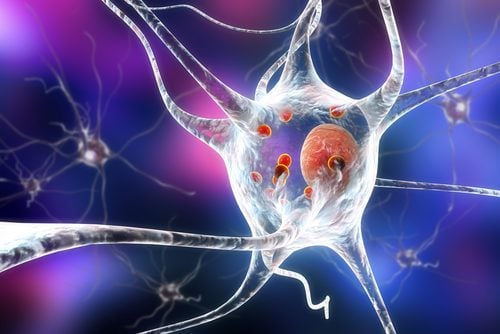
In bulbar ALS, the muscles involved in breathing, speaking, and swallowing are usually affected first. “First” is important in this context: Eventually, everyone with ALS will experience bulbar symptoms.
What is Bulbar ALS?
Bulbar onset ALS is a form of ALS that mainly affects the motor neurons within the bulbar region of the brainstem.
With this condition, functions like speech, breathing, and swallowing are impacted. Signs of bulbar ALS include breathing difficulties, swallowing problems, and weakness of facial muscles.
Bulbar ALS represents the minority of ALS cases, with the majority being sporadic.
Here are six things to understand about bulbar ALS:
1. It Impairs Swallowing
Dysphagia — difficulty in swallowing — is a common symptom of bulbar ALS. Among the symptoms are:2,3
- Frequent coughing or choking on food while swallowing
- A gurgling voice after swallowing
- Foods or liquids spilling out of the mouth
- A buildup of saliva in the mouth
- Food coming out the nose
- Regurgitation
- Shortness of breath while eating
Difficulty swallowing increases the risk of aspiration — food or liquid going into the windpipe. This can cause infections and other complications.
Reduced caloric intake is a significant issue. Dysphagia, obviously, makes eating difficult. But that’s not the only issue: People with ALS burn calories at a faster rate than average. Fatigue can also lead to eating less food and less often. As a result, these individuals can lose weight rapidly and become malnourished.4 Ultimately, eating may be impossible, and that’s when a feeding tube will be needed.
2. It Affects the Ability to Speak
The same bulbar motor deterioration that impairs swallowing also makes it difficult to speak. Speech impairment (dysarthria) is another early symptom of bulbar-onset ALS.
ALS leads to the degeneration of the nerve cells responsible for bringing messages from the lower parts of the brain (bulbar region) to the muscles of the lips, tongue, soft palate, jaw and voice box. Eventually, the muscles become weak and tight, limiting tongue, lip and/or jaw movement.5
Perhaps the most obvious result is slow, slurred, and difficult-to-understand speech. A person with bulbar ALS will have poor articulation and difficulty forming words. Other symptoms include:6,7,8
- Difficulties managing the voice’s pitch, tone and rhythm.
- Nasal-sounding voice
- Hoarse or strained voice
- Decrease in vocal range or loudness
- Changes in speech patterns.
No matter how the disease begins, most (80% to 95%) people with ALS will, at some point, experience these symptoms to the point that they won’t be understood without some sort of assistance.9
You can learn more about the ways ALS affects speech here.
3. It’s More Aggressive
Bulbar onset ALS tends to progress faster than limb-onset ALS. That means that these people with ALS experience a faster decline, and shorter survival — often less than two years.10
One study found that cognitively healthy people with ALS have brain damage that reflects the type of ALS they have. Those with bulbar ALS have more widespread brain tissue loss. This could explain why bulbar ALS is more aggressive.11
4. Bulbar Onset is Diagnosed Sooner
Bulbar ALS is diagnosed earlier than limb-onset ALS.12 One study suggests that dysarthria symptoms may appear up to three years before the diagnosis of bulbar-onset ALS.13
5. It May Be More Common in Women
Although ALS tends to affect more men than women, bulbar-onset appears to be slightly more common in women.14,15
6. Symptoms Vary by Individual
Each patient may experience bulbar-onset ALS differently. In people with bulbar ALS:16,17
- Dysarthria — with eventual loss of speech — occurs nearly 95% of the time
- Dysphagia occurs in roughly 85% of patients
- Involuntary tongue twitching (tongue fasciculation) occurs nearly two-thirds of the time
- Vocal cord spasms occur about 20% of the time.
Bulbar ALS may be aggressive, but people with ALS and their loved ones can take steps to improve the quality of life and mitigate some of the symptoms. To learn more about this — and about ALS in general — visit www.targetals.org/news-stories/.
Other ALS Throat Symptoms
Dysphonia
Dysphonia is a condition characterized by changes in voice quality, pitch, loudness, or resonance due to problems with the vocal cords or the muscles that control them. It can manifest as hoarseness, breathiness, strained voice, or a tremulous voice. Dysphonia can occur due to various reasons, including neurological conditions like ALS, vocal cord paralysis, vocal fold nodules or polyps, laryngitis, or muscle tension dysphonia.
In ALS, dysphonia typically arises from weakness or paralysis of the muscles involved in phonation (producing sound). As the disease progresses, the muscles in the throat and voice box (larynx) weaken, leading to changes in the voice. This can result in a softer voice, changes in pitch, or difficulty modulating vocal tone.
Treatment for dysphonia in ALS may involve speech therapy to help maintain vocal strength and coordination for as long as possible. Techniques such as vocal exercises, breathing exercises, and strategies for conserving energy during speech may be recommended. In some cases, augmentative and alternative communication (AAC) devices may be used to facilitate communication as speech becomes more difficult.
Throat Clearing or Coughing
As ALS progresses, weakness and paralysis can extend to the muscles responsible for coughing and clearing the throat. These muscles play a crucial role in maintaining a clear airway by expelling irritants, mucus, or foreign particles. When these muscles weaken, individuals may experience difficulty in effectively clearing their throat or coughing.
Types of ALS Breakdown
Here’s a breakdown of the primary types of ALS:
Sporadic ALS: Sporadic ALS is the most common form, accounting for approximately 90-95% of all cases. It occurs randomly and without a clear genetic predisposition. Sporadic ALS can affect individuals of any age, although it typically manifests in adulthood, usually between the ages of 40 and 70.
Familial ALS: Familial ALS accounts for approximately 5-10% of all cases and is inherited in an autosomal dominant pattern, meaning that a mutation in a single gene copy inherited from one parent is sufficient to cause the disease. Familial ALS tends to occur earlier in life compared to sporadic ALS, with symptoms often appearing before age 40. Several genes have been associated with familial ALS, including SOD1, C9orf72, FUS, and others.
Primary Lateral Sclerosis (PLS): PLS is considered a subtype of ALS characterized by progressive upper motor neuron dysfunction, primarily affecting the motor cortex in the brain. Unlike classic ALS, PLS predominantly involves muscle stiffness, weakness, and spasticity in the limbs, particularly the legs, without significant lower motor neuron involvement. PLS progresses more slowly than typical ALS, and some individuals with PLS may not develop lower motor neuron symptoms characteristic of ALS.
Progressive Muscular Atrophy (PMA): PMA is another subtype of ALS characterized by selective degeneration of lower motor neurons, leading to muscle weakness and atrophy. Unlike classic ALS, PMA primarily affects the lower motor neurons in the spinal cord and brainstem, resulting in weakness and wasting of muscles without significant upper motor neuron involvement. PMA tends to progress more slowly than typical ALS and may have a better prognosis.
Flail Arm Syndrome (FAS) and Flail Leg Syndrome (FLS): These are rare variants of ALS characterized by predominant weakness and atrophy in either the upper limbs (FAS) or lower limbs (FLS), respectively, without significant involvement of other muscle groups. These syndromes may progress more slowly than typical ALS and often have distinct clinical features.
Respiratory Onset ALS: Some individuals with ALS may initially present with respiratory symptoms, such as shortness of breath, difficulty breathing, or frequent respiratory infections, before developing classical motor symptoms. Respiratory onset ALS tends to progress rapidly and may have a poorer prognosis compared to other forms of ALS.
It’s important to note that while these types provide a framework for understanding the clinical heterogeneity of ALS, there can be overlap between subtypes, and individuals may exhibit features of more than one type over the course of the disease. Additionally, ongoing research is uncovering new genetic and clinical subtypes of ALS, further refining our understanding of this complex disease.
Sources
1 alsnewstoday.com/forms-of-als/
2 alsnewstoday.com/als-symptoms/difficulty-swallowing/
3 Green JR, et al. Bulbar and speech motor assessment in ALS: challenges and future directions. Amyotroph Lateral Scler Frontotemporal Degener. 2013;14(7-8):494-500. doi:10.3109/21678421.2013.817585
4 www.als.org/blog/11-ways-maintain-nutrition-people-als
5 Green JR, et al. Bulbar and speech motor assessment in ALS: challenges and future directions. Amyotroph Lateral Scler Frontotemporal Degener. 2013;14(7-8):494-500. doi:10.3109/21678421.2013.817585
7 https://www.als.net/news/science-sunday-limb-and-bulbar-onset-als/
8 https://alsnewstoday.com/speech-problems/
9 Brent JR, Franz CK, Coleman JM 3rd, Ajroud-Driss S. ALS: Management Problems. Neurol Clin. 2020;38(3):565-575. doi:10.1016/j.ncl.2020.03.013
10 Shellikeri S, et al. The neuropathological signature of bulbar-onset ALS: A systematic review. Neurosci Biobehav Rev. 2017;75:378-392. doi:10.1016/j.neubiorev.2017.01.045
12 Richards, D, et al. Time to diagnosis and factors affecting diagnostic delay in amyotrophic lateral sclerosis. Journal of the Neurological Sciences 417 (2020)
13 Tena A, et. al. Detection of Bulbar Involvement in Patients With Amyotrophic Lateral Sclerosis by Machine Learning Voice Analysis: Diagnostic Decision Support Development Study. JMIR Med Inform. 2021;9(3):e21331. Published 2021 Mar 10. doi:10.2196/21331
14 Zhang, H. et al.: Disease duration of progression is helpful in identifying isolated bulbar palsy of amyotrophic lateral sclerosis. BMC Neurology 21 (2021)
15 Richards, D, et al. Time to diagnosis and factors affecting diagnostic delay in amyotrophic lateral sclerosis. Journal of the Neurological Sciences 417 (2020)
16 Bulbar ALS, AMYOTROPHIC LATERAL SCLEROSIS SOCIETY OF CANADA
17 Shipley, P.Z. Life patterns of family caregivers of patients with amyotrophic lateral sclerosis. https://etda.libraries.psu.edu/catalog/15131






